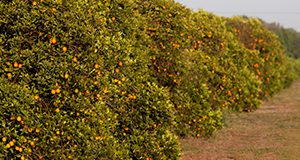This 2-page fact sheet written by Christa D. Court, Alan W. Hodges, Mohammad Rahmani, and Thomas H. Spreen and published by the UF/IFAS Food and Resource Economics Department describes the economic contributions of the citrus industry to the state of Florida in fiscal year 2015/16, updating previous studies for 2012/13 and 2014/15 and previous estimates for the economic impacts of citrus greening disease.
edis.ifas.ufl.edu/fe1021
Tag: Thomas H. Spreen
Citrus Greening and Citrus Tree Planting in Florida
 This 4-page fact sheet examines the impact of the presence of citrus greening on new tree plantings in the Florida citrus industry. Sweet oranges are by far the most important citrus variety grown in Florida, so the analysis is limited to sweet orange plantings. Because citrus greening impacts citrus producers through reduced yield, increased mortality, and increased cost of production, it is expected that the presence of citrus greening has had an adverse impact on the willingness of growers to invest in new trees. Written by Thomas H. Spreen and Jean-Paul Baldwin, and published by the UF Department of Food and Resource Economics, January 2014.
This 4-page fact sheet examines the impact of the presence of citrus greening on new tree plantings in the Florida citrus industry. Sweet oranges are by far the most important citrus variety grown in Florida, so the analysis is limited to sweet orange plantings. Because citrus greening impacts citrus producers through reduced yield, increased mortality, and increased cost of production, it is expected that the presence of citrus greening has had an adverse impact on the willingness of growers to invest in new trees. Written by Thomas H. Spreen and Jean-Paul Baldwin, and published by the UF Department of Food and Resource Economics, January 2014.
http://edis.ifas.ufl.edu/fe937
Economic Impacts of Citrus Greening (HLB) in Florida, 2006/07-2010/11 (FE903)
 Since 2006, the bacterial disease citrus greening has cost Florida’s economy an estimated $3.636 billion in lost revenues and 6,611 jobs by reducing orange juice production, according to the study reported in this 5-page fact sheet written by Alan W. Hodges and Thomas H. Spreen and published by the UF Department of Food and Resource Economics, January 2012.
Since 2006, the bacterial disease citrus greening has cost Florida’s economy an estimated $3.636 billion in lost revenues and 6,611 jobs by reducing orange juice production, according to the study reported in this 5-page fact sheet written by Alan W. Hodges and Thomas H. Spreen and published by the UF Department of Food and Resource Economics, January 2012.
http://edis.ifas.ufl.edu/fe903
UF/IFAS press release: http://news.ufl.edu/2012/01/24/greening-cost/
FE812 The Florida Citrus Industry: Government and Non-Government Organizations
FE812, a 5-page fact sheet by Thomas H. Spreen, Ronald P. Muraro, Fritz M. Roka, and R. Allen Morris, identifies the major organizations that work for the benefit of the Florida citrus industry and provides a brief introduction to their activities. Published by the UF Department of Food and Resource Economics, October 2009.
http://edis.ifas.ufl.edu/FE812
FE754 Economic Impacts of the U.S. Sugar Corporation in Florida: Implications of the Purchase by the State of Florida
FE754, a 10-page illustrated report by Alan W. Hodges, W. David Mulkey, Thomas H. Spreen, and Rodney L. Clouser, evaluate the economic impacts of the current operations of USSC and the potential impact under the proposed purchase, based on publicly available
information from the company’s website (http://www.ussugar.com
) and other sources. Includes references. Published by the UF Department of Food and Resource Economics, October 2008.
http://edis.ifas.ufl.edu/FE754
FE755 Cuban Agriculture and the Impacts of Tropical Storm Fay and Hurricanes Gustav and Ike
FE755, a 9-page illustrated fact sheet by William A. Messina, Jr., Frederick S. Royce, and Thomas H. Spreen, attempts to assess the damage to Cuban agriculture caused by these three storms which hit the island within a three week period in 2008. Includes references. Published by the UF Department of Food and Resource Economics, October 2008.
http://edis.ifas.ufl.edu/FE755
